
8 Best Medical Simulation Companies for All Healthcare Needs
8 Best Medical Simulation Companies for Every Healthcare Need
Medical simulation companies complement doctors’ and nurses’ skills with advanced training tools. The global medical simulation market was estimated at $1.65 billion in 2024, and it’s on track to grow even more significantly.
That means hospitals, medical schools, and healthcare institutions have more options than ever. But with all these choices, how do you pick the right one?
In this article, we’ll list the top companies in the medical simulation market. We’ll explain what they offer, what makes them stand out, and how they can help you tackle your healthcare training challenges.
What Is a Medical Simulation Company?
A medical simulation company develops training programs and technologies that replicate clinical settings. These simulations help healthcare professionals practice medical procedures without risks to real patients. They may use virtual reality, mannequins, or software to create realistic medical scenarios.
Medical simulation companies cater to various healthcare sectors, including surgery, emergency medicine, maternal and neonatal care, and general clinical skills training. Their offerings are widely used by:
- Hospitals
- Medical schools
- Nursing programs
- Military organizations
Some companies also integrate artificial intelligence (AI) and analytics to provide feedback and tailor simulations to individual learners’ needs.
Why Is Medical Simulation Important?
Medical errors are the third leading cause of death in the US. Medical simulation creates a safe, controlled environment where medical professionals can practice without risking patient safety.
Medical simulation bridges the gap between theoretical knowledge and practical application, ultimately enhancing patient outcomes. It can improve decision-making skills in various scenarios, including high-stakes emergencies.
Simulating real-world scenarios also helps trainees build confidence and improve critical thinking.
Types of Medical Simulation Solutions
Here are the main types of medical simulation solutions:
Virtual Reality (VR) Simulators
These create immersive, interactive environments where learners can practice procedures and decision-making in a virtual space.
VR simulators are particularly effective for simulating complex or rare scenarios that are difficult to replicate in traditional settings.
For Example, Lumeto is a medical simulation company that offers highly realistic simulations tailored to healthcare professionals. Our platform combines immersive technology with customizable scenarios to improve real-world readiness. The video below shows how students use Lumeto’s VR platform to engage in medical training.
Research shows that VR simulators frequently achieve educational outcomes on par with or surpass those of traditional simulation methods.
Physical Simulators (Mannequins)
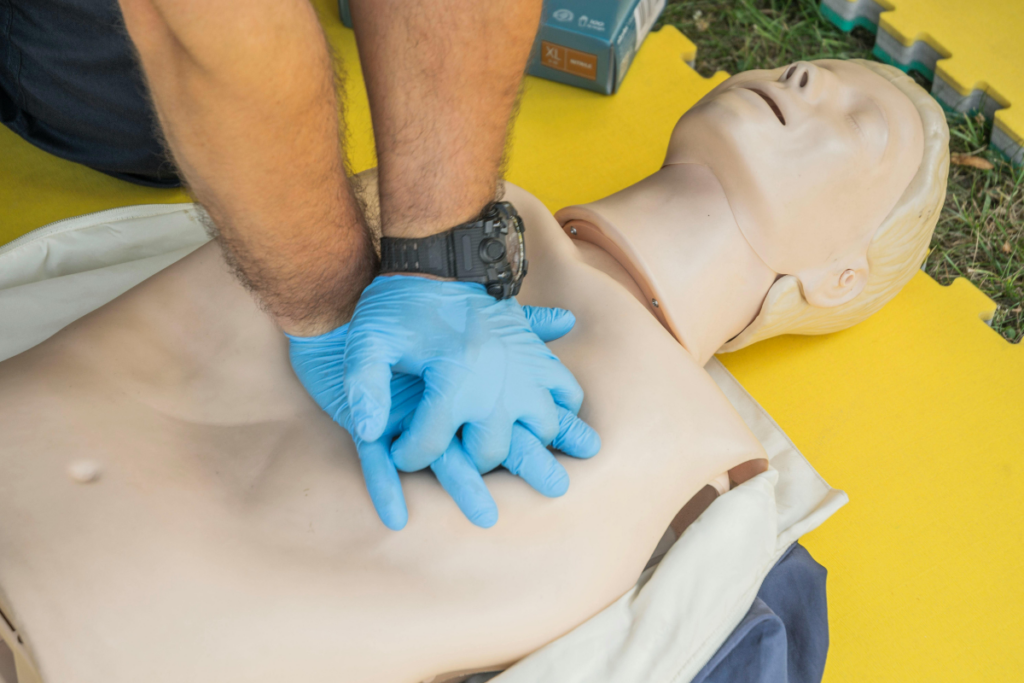
A mannikin in medical training is a life-sized model used to simulate the human body for medical education and practice. It is typically made of durable materials like plastic, silicone, or rubber.
High-fidelity mannequins replicate human anatomy and physiology, allowing learners to perform hands-on procedures like intubation or CPR.
Advanced models can simulate breathing, heartbeats, and other physiological responses.
Task Trainers

A task trainer in medical training is a simulation device designed to replicate specific anatomical structures or procedures.
These focus on specific skills, such as suturing, catheter insertion, or IV placement, providing targeted practice for critical tasks.
Screen-Based Simulations

Screen-based simulations are digital, interactive tools replicating medical scenarios or procedures. These simulations typically run on computers, tablets, or other flat-screen devices. It’s a commonly used method in diagnostic reasoning.
Screen-based simulations are viewed flat-screen, while VR immerses the user in a 3D environment using headsets.
How to Choose a Medical Simulation Company
Let’s explore what you need to consider when choosing a medical simulation company.
Quality and Realism of Simulation Tools
The quality and realism of medical simulation equipment are critical for practical training. It directly influences the learner’s experience and skill development.
In VR simulators, visual and sensory realism is everything. The quality of graphics, frame rates, and responsiveness impacts how immersive the experience feels. If a tool doesn’t look or respond realistically, it can take trainees out of the moment and reduce learning effectiveness.
Smart AI-powered platforms can also adapt to real-life scenarios based on the trainee’s actions. For instance, if a trainee misses a critical step in a diagnostic scenario, the AI can adjust the case to simulate the consequences.
Durability is crucial for physical simulators to maintain realism over time. Tools that degrade or require constant repairs lose their ability to provide consistent training.
Compatibility With Existing Infrastructure
Simulation tools should work seamlessly with your existing hardware, such as monitors, projectors, or VR headsets. For medical simulation software, it’s important to check if it integrates with your institution’s learning management system (LMS) or other educational platforms.
Physical simulators and VR setups often come with specific space requirements. For instance, high-fidelity mannequins might need dedicated rooms with adequate power and network access, while VR simulators may require open, unobstructed spaces for safe movement. Make sure the tools you choose fit your training spaces without costly modifications.
Many simulation tools rely on strong internet or network connections for real-time updates, cloud storage, or multi-user sessions. Check whether your current network infrastructure can support these demands.
Support and Training
A good simulation company should provide comprehensive training for your team during the setup phase. Look for providers that also offer reliable ongoing support.
Companies that offer guidance in creating custom scenarios to your institution’s needs can save you time and maximize the value of your investment.
Online resources like video tutorials, FAQs, and user forums usually empower your staff to solve minor issues independently.
Budget and ROI.
Simulation tools vary widely in price. While it’s tempting to focus solely on upfront costs, it’s equally important to think long-term. Maintenance, software updates, replacement parts, or cloud subscription fees can impact your budget.
Think ahead. If your institution plans to expand its training program, will the simulation tools grow with you?
Top Medical Simulation Companies in 2025
Medical simulation companies are offering cutting-edge tools that merge technology with education. They are pushing boundaries with VR, AI, and advanced hardware that make healthcare training more effective.
Let’s take a closer look at some of the top players in the medical simulation industry this year.
Lumeto – Best VR Medical Simulation Company
Lumeto stands out as a leader in virtual reality-based healthcare training. It combines advanced AI with a user-friendly, immersive VR experience that adapts to unique training needs. It’s easy to implement, evidence-based, and designed for maximum impact.
Our platform also includes the largest library of competency-mapped learning experiences created by clinicians for clinicians. All of them are fully customizable—patients, conditions, vitals, dialogues, and even medications can be adapted to suit specific training goals.
At Lumeto, we serve a broad range of learner groups, including:
- Pre-licensure and practicing nurses
- Medical students, residents, and fellows
- Interprofessional healthcare teams
- Police and armed forces trainers
- Mobile and remote healthcare workers
A study co-developed with CHEST validated the effectiveness of Lumeto’s Immersive Difficult Airway Management VR lesson. Results showed a 26% increase in procedural knowledge after just one 25-minute VR session.
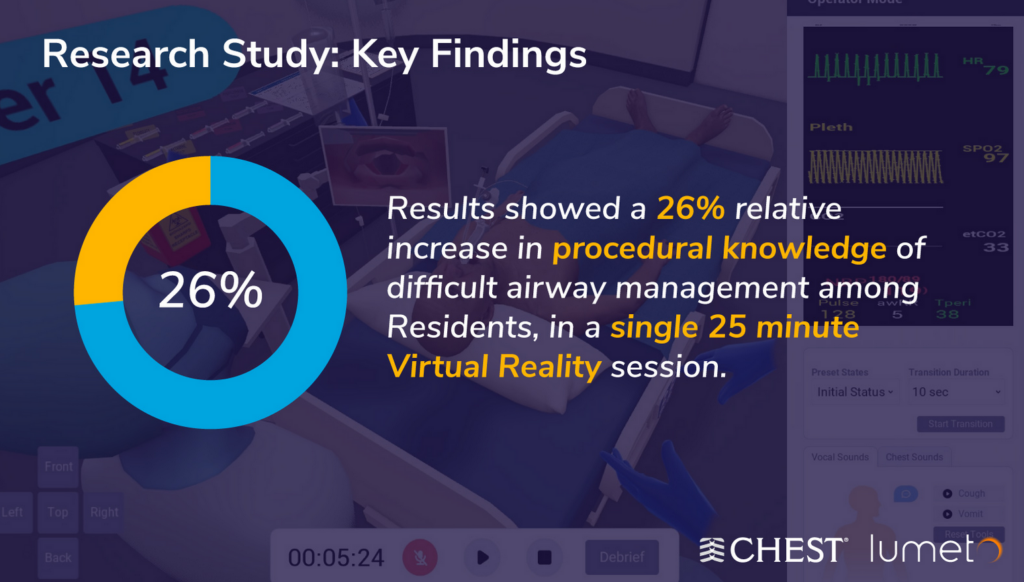
See how Lumeto can help with your healthcare training. Start your trial today!
Gaumard Scientific — Best for Maternal and Neonatal Care
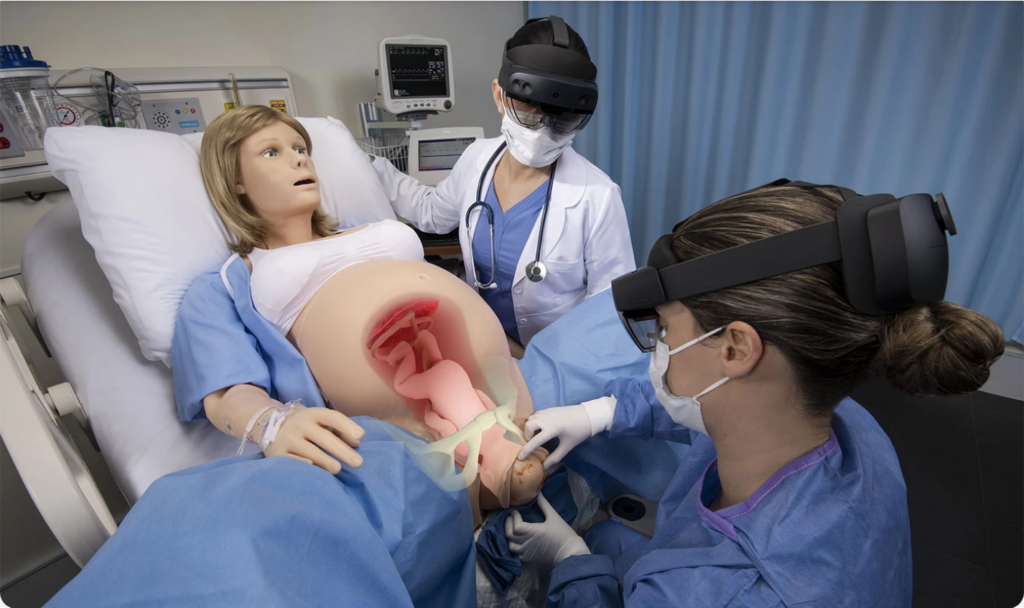
Gaumard Scientific, a Florida-based company, specializes in high-fidelity medical simulation, especially in maternal and neonatal care. Gaumard is renowned for its cutting-edge OB birth simulators, including Noelle and Victoria. Moreover, Gaumard offers advanced pediatric simulators like the Super Tory and the Hal S2225 for neonatal care.
Gaumard markets its products directly in the U.S. and through an extensive network of distributors spanning 70 countries.
VirtaMed — Best for Minimally Invasive Surgical Training
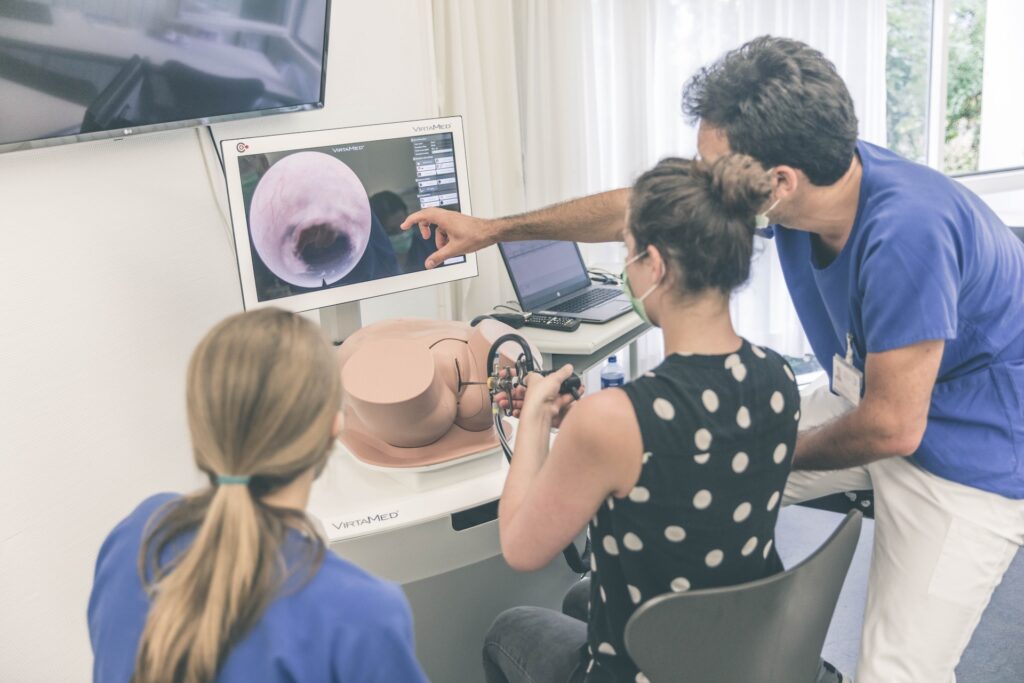
VirtaMed combines virtual reality training with real surgical instruments. Their mixed reality simulators incorporate genuine surgical tools. This allows practitioners to become familiar with the equipment they will use during actual procedures.
VirtaMed’s haptic technology provides lifelike tactile sensations, enhancing training authenticity.
Here are VirtaMed’s specialized simulators:
- ArthroS™: Focuses on orthopedic procedures, offering training modules for knee, shoulder, hip, and ankle arthroscopy.
- LaparoS™: Designed for general surgery, this simulator provides a platform for practicing various laparoscopic techniques.
- GynoS™: Covers a spectrum of OB/GYN training, including obstetric ultrasound, hysteroscopy, embryo transfer, and IUD placement.
- UroS™: Offers training for urologic procedures such as TURP, TURB, and laser enucleation of the prostate.
Mentice — Best for Vascular and Interventional Simulation
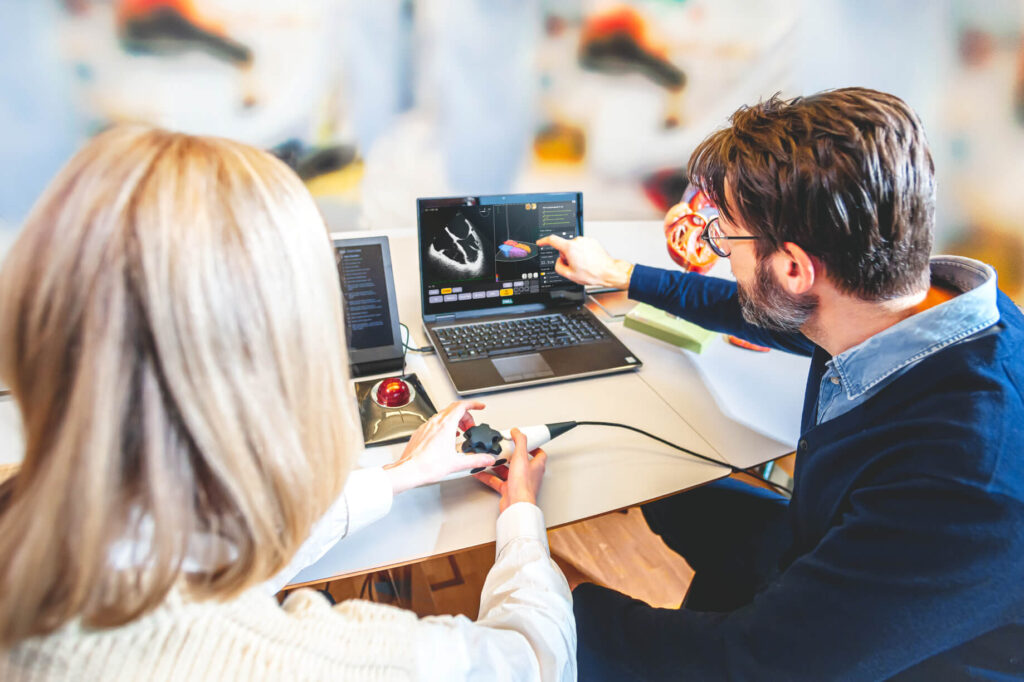
Mentice provides simulation solutions for Image-guided Interventional Therapies (IGIT). It covers various interventions, including neurovascular, cardiovascular, and peripheral vascular procedures.
The two most notable platforms of Mentice include:
- VIST® G7 and G7+: These flagship simulators offer advanced force feedback and support for simultaneous manipulation of multiple devices. They facilitate training in complex techniques like bifurcation stenting and balloon-assisted coiling.
- VIST® Virtual Patient: Integrates with leading angiography systems to convert angio suites into comprehensive training environments, enabling realistic procedure rehearsals and team training.
Anatomage — Best for Anatomical Visualization
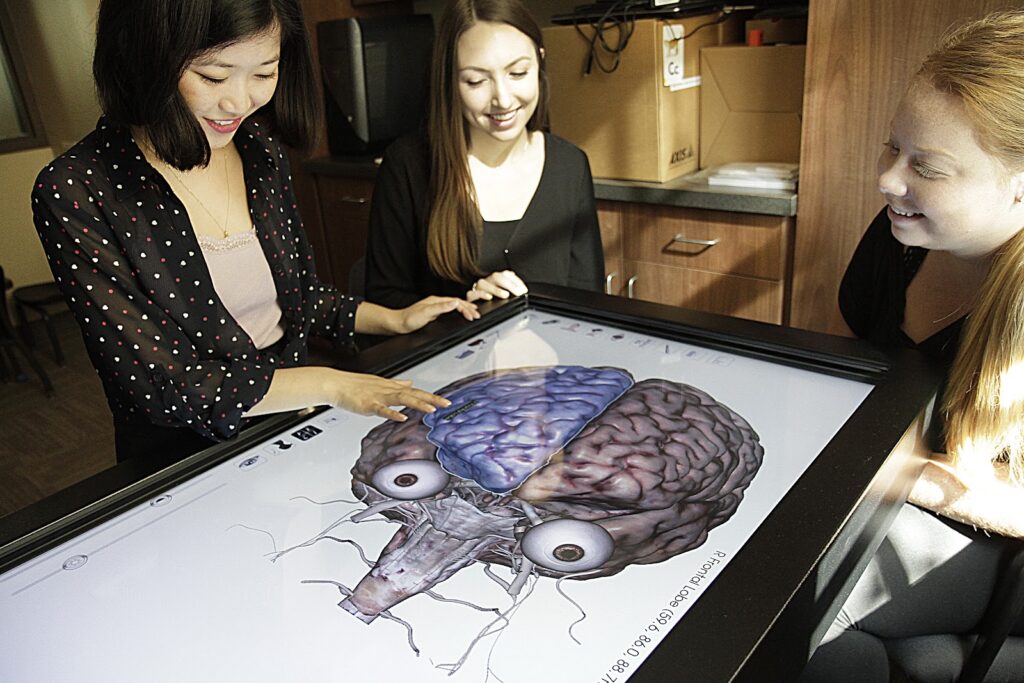
Anatomage is a medical simulation company that offers advanced tools that transform the study of human anatomy.
Their flagship product, the Anatomage Table, is a life-size, interactive platform that allows users to explore detailed 3D representations of human anatomy. It is distinguished by its real cadaveric content, derived from high-resolution scans of actual human bodies.
Beyond educational settings, the Anatomage Table is a valuable resource in clinical applications. Its FDA-cleared software allows medical professionals to interpret, analyze, and examine patient scans (utilizing 3D DICOM rendering capabilities).
Kavo Dental — Best Dental Simulation Company
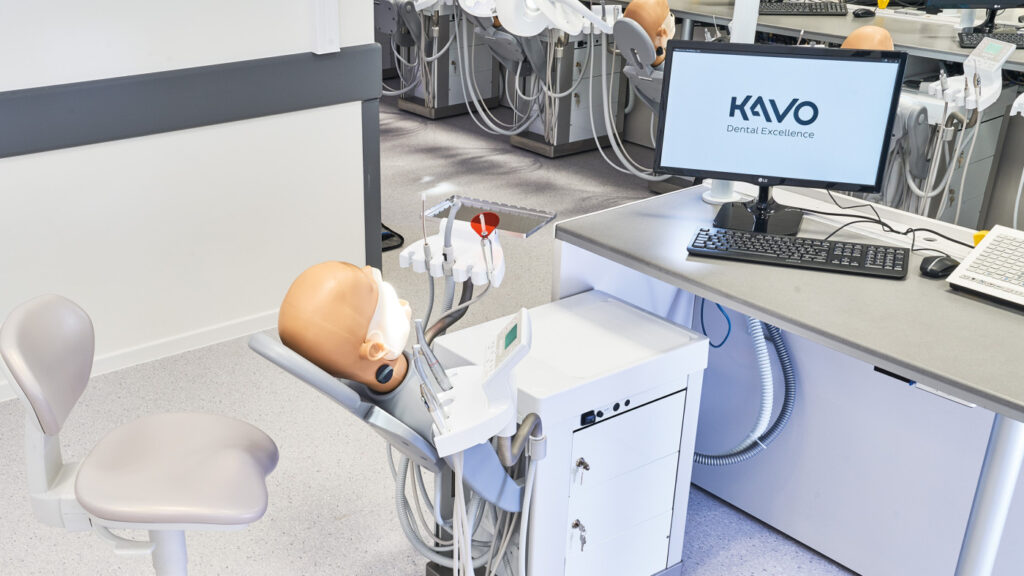
KaVo Dental is a premier provider of dental simulation solutions. Their simulation units, such as the DSE Clinical™ E50 Life and DSE™ Expert, replicate real-world dental procedures. These units feature adjustable dentist and assistant elements, integrated patient simulators, and flexible instrumentation.
In addition to simulation units, KaVo provides dental patient simulators that closely mimic actual patient interactions. The modular design allows for customization with different jaw simulators, face masks, and tooth models.
Operative Experience – Best for Combat and Trauma Simulation

Operative Experience Inc. (OEI) specializes in hyper-realistic medical simulators for combat and trauma training. Their products are designed to enhance the skills of military personnel and first responders in high-stress environments.
Some of their notable simulation platforms include:
- Tactical Casualty Care Simulator (TCCS) Pro: Provides training for hemorrhage control and airway management, featuring lifelike tissue and articulating limbs.
- Prolonged Casualty Care Simulator (PCCS) Pro: Offers prolonged care training with advanced physiological modelling and modular wound configurations.
- Tactical Hemorrhage Control Trainer (THCT) Pro: Focuses on rapid assessment and hemorrhage control, ideal for Tactical Combat Casualty Care (TCCC) training.
Future Trends in Medical Simulation
The future of medical simulation is exciting, with rapid advancements and innovations, reshaping how healthcare professionals train and learn.
VR Takes the Spotlight
Virtual Reality (VR) is rapidly gaining traction in medical education. Many companies are transitioning to VR-based solutions to provide immersive, interactive training experiences. VR makes it easier than ever to simulate complex scenarios in a safe and controlled virtual environment.
As VR grows, medical simulation mannequin manufacturers strive to make their models more realistic. They will want to improve anatomical accuracy and enhance haptic feedback to compete with VR systems.
Accessible Training Solutions
The future of medical simulation is becoming more inclusive and accessible. Simulation software is being optimized to run on less expensive hardware and standard internet connections.
Platforms like Lumeto’s InvolveXR, which operates seamlessly on residential-grade Wi-Fi, are paving the way for more widespread adoption of simulation tools.
Artificial Intelligence Integration
AI is revolutionizing medical simulation by enabling:
- Generative AI patients.
- Adaptive training modules.
- And real-time feedback systems.
AI-driven tools can analyze performance, personalize learning experiences, and simulate realistic patient interactions.
As Kimberly Workum from the University of Manitoba shares:
Working with AI patients in Lumeto evokes an emotional response that mirrors interactions with human patients. The joy of making a breakthrough in patient communication or the sadness felt during a patient's distress highlights the system's realism and immersiveness. This emotional engagement makes each simulation a powerful tool for honing empathetic and professional nursing skills.
Kimberly Workum, Rady Faculty of Health Sciences at the University of Manitoba
Final Thoughts
As healthcare demands grow more complex, the need for advanced training solutions has never been greater. Medical simulation offers the flexibility and realism needed to prepare teams for anything.
Lumeto’s InvolveXR provides an innovative, customizable platform to meet these evolving needs. Curious about what the future of healthcare training looks like? Lumeto might just be the answer. Book a demo today!
Frequently Asked Questions About Healthcare Simulation Companies
What medical professionals benefit from simulation training?
Medical simulation training benefits a wide range of healthcare professionals, including doctors, nurses, paramedics, surgeons, medical students, and even non-medical staff like police officers and military medics.
What is the difference between low-fidelity and high-fidelity simulators?
Low-fidelity simulators are basic tools designed for practicing specific tasks, like inserting IVs or suturing. High-fidelity simulators, on the other hand, are advanced systems that mimic real-life physiological responses, complex scenarios, and patient interactions.
Do medical simulation tools support multilingual training?
Yes, many simulation platforms include multilingual options or allow educators to customize language settings to cater to diverse learners and global institutions.
Can simulation tools replicate emotional or psychological aspects of patient care?
Yes, tools like Lumeto include AI-powered patient simulations that mimic emotional responses, such as fear, anxiety, or gratitude. It helps learners practice empathy, communication, and bedside manner.